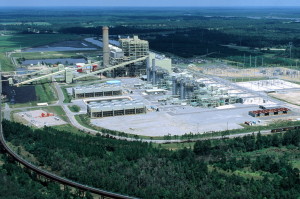Expert says EPA regulations are gigantic ‘transfer of wealth’

ON THE CHOPPING BLOCK: Coal-fired power plants like Mississippi Power’s Plant Daniel could be an endangered species under new EPA regulations proposed by the Obama administration.
By Steve Wilson | Mississippi Watchdog
New regulations released last week by the Environmental Protection Agency governing greenhouse gas emissions from power plants could be one of the largest transfers of wealth in history.
Jason Hayes, the assistant director of the American Coal Council, said the bill for climate change is being handed to the U.S. ratepayer as developing nations like China and India increase their greenhouse gas emissions in the face of U.S. cuts. China and India are two of the nations Hayes said are benefiting from U.S. policies on energy.
“Essentially, it’s a gigantic transfer of wealth to the developing world,” Hayes said. “They considered it to be immoral to not raise themselves up out of poverty. They said you can’t ask us not to do that.”
China’s CO2 emissions have risen 180 percent between 1999 and 2011 and was responsible for 27 percent of the world’s CO2 output in 2011. In that same span, India’s CO2 emissions increased 68 percent.
The bill to Americans for increased emissions in the developed world isn’t going to be cheap.
A study released by the U.S. Chamber of Commerce’s Institute for 21st Century Energy said the regulations, designed to cut emissions from coal-fired power plants by 30 percent from 2005 levels by 2030, could cost the U.S. economy $50 billion and 224,000 jobs each year through 2030. Coal accounted for 39 percent of the nation’s electrical generation capacity in 2013.
The United States has the world’s largest reserves with production of 1 billion short tons in 2013, the lowest total since 1993. Under the new regulations, older coal plants that still have plenty of life in them would have to be shuttered to comply with the new regulations.
Increased energy costs from shuttering coal plants would be passed on at all levels of the economy, giving rise to serious inflationary pressure. According to the Department of Energy, plants that supply the equivalent of 33 million homes will close by 2020.
“The bottom line is prices will go up and ratepayers will pay more,” Hayes said. “The thing with those older plants is they were already paid for. So what’s coming up in its place is new construction and you’re going to have to be paying off the capital on those power plants. The older coal plants were paid for, so you could operate them for the cost of fuel and your overhead costs.”
But the administration claims that instead of going up, power rates will decrease 8 percent by “increasing energy efficiency and reducing demand in the electricity system.”
PREPARE TO PAY: Gross domestic product and job losses by region from the U.S. Chamber of Commerce’s report on the Obama administration’s new regulations on coal-fired power plants.
With coal largely off the table thanks to the regulations, the nation’s energy needs would have to be met by the triad of nuclear, natural gas and renewable sources. All have serious issues.
Natural gas prices were hard hit by the polar vortex cold snap that raised rates by 44 percent. Natural gas represented 27 percent of the nation’s electrical generation capacity in 2013. Making it the primary source of the nation’s electricity is not without its drawbacks, despite the United States being the world’s largest natural gas producer.
“The pressure on natural gas is definitely going to go up,” Hayes said. “There is more natural gas being produced domestically, which is good for the economy. It’ll help relieve some of the pressure, but as demand grows, the supply is going to have to catch up.”
Nuclear energy’s future under the new regulations might be on the rise despite the Fukushima disaster in 2011, but the regulatory hurdles required to build new power plants are extreme. The Obama administration is even helping fund several new nuclear plants, with a $6.5 billion loan guarantee to the Southern Company to build a plant in Georgia and $452 million to design and build small modular reactors.
The administration approved new plants in Tennessee and South Carolina as well as Georgia in 2012. At present, nuclear energy provides 19 percent of the nation’s electrical generation capacity.
Renewable sources represent 13 percent of the nation’s electrical generation capacity, with 52 percent of that from hydroelectric and 32 percent from wind power. But those numbers do come with a powerful caveat.
“The only reason that renewables have cost parity with nuclear, natural gas and coal is because of massive handouts,” Hayes said. “The way it’s set up, you can produce renewable electricity at a loss and still make money because the government is handing you dollars per megawatt hour.”
According to the Institute for Energy’s Hard Facts study, government subsidies were $775.64 per megawatt hour for solar power and $56.29 for wind. In comparison, nuclear subsidies per megawatt hour were $3.14. Hydroelectric power was 82 cents per megawatt hour, while subsidies for coal, natural gas and petroleum liquids were 64 cents apiece.
Contact Steve Wilson at swilson@watchdog.org
Get regular updates on Mississippi through our Facebook or Twitter accounts








